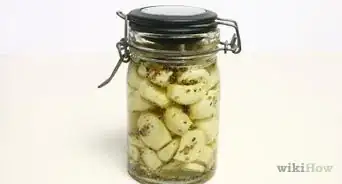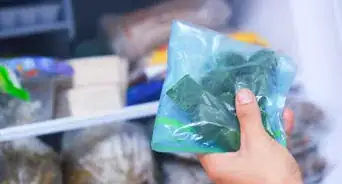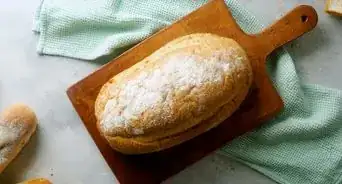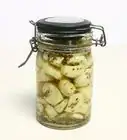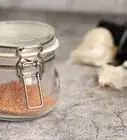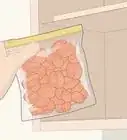wikiHow is a “wiki,” similar to Wikipedia, which means that many of our articles are co-written by multiple authors. To create this article, 11 people, some anonymous, worked to edit and improve it over time.
There are 7 references cited in this article, which can be found at the bottom of the page.
wikiHow marks an article as reader-approved once it receives enough positive feedback. In this case, several readers have written to tell us that this article was helpful to them, earning it our reader-approved status.
This article has been viewed 142,038 times.
Learn more...
While there is some argument as to whether or not frozen garlic still tastes good upon thawing, it is possible to freeze garlic. You may want to experiment with a small amount first and make your own mind up about the success or otherwise of freezing it but it can be very useful if you suddenly have a glut of garlic on your hands.
Steps
Whole Garlic
-
1Select quality garlic bulbs. Remove any dirt you can see just by wiping gently.[1]
-
2Toss it inside a resealable freezer bag. Label and date (the date is more important; you can probably see it's a garlic bulb).[2]Advertisement
-
3Use. All you need to do is peel off a clove, peel it and use as normal.[3] It won't take long to thaw but you can grate or chop it (with a sharp knife) while still frozen if you're careful.
Chopped Garlic or Whole Cloves
-
1Remove the garlic cloves from the bulb. Peel each one.
-
2Either leave as a clove or chop into small pieces.
-
3Wrap the cloves or chopped garlic in plastic wrap or foil. Place the wrapped garlic inside a resealable freezer bag.[4]
-
4Freeze. Use by breaking off whatever is needed from the chopped mass, or simply take a clove (if the clove has gone mushy, it's only good for cooking that lets it break down even more). The frozen mass can be grated, as can the clove if it has remained intact.
- Use within six months.
Oily Garlic
This method requires that you don't delay in freezing the result, to avoid possible food poisoning (see Warnings below).
-
1Select a suitable garlic bulb. Separate the cloves from it and peel them.
-
2Place the cloves into a food processor or blender. Add oil in the ratio of 2 parts oil to 1 part garlic.[5]
- Olive oil is a good choice, or a less strong flavored vegetable oil of your choosing.
-
3Puree or blend to combine the two ingredients. Transfer to a freezer-proof container with a lid to prevent odor transference.
-
4Use. Stick a teaspoon or butter knife in and retrieve as much oily garlic as needed for such things as making pasta sauce, adding garlic flavor to meats, stews and other dishes and for adding to stir-fries or sautée-ing.
- Do not let this mixture sit at room temperature; either keep it frozen or heat it up immediately.
Community Q&A
-
QuestionHow long can I keep garlic puree frozen?
 MicheleTop AnswererPuréed garlic loses its oils very quickly, and a lot of flavor can be lost as well. Combine it with something else you'll use in cooking, such as making a garlic compound butter, heavy on the garlic. Roll it into a log and freeze. You can then cut off what you need when you need it, and it should last a good long while in the freezer. Another alternative is to add lots of it to chicken stock and freeze in ice cube trays. Again, it's something that you will often use in combination anyway, and easy to then portion out.
MicheleTop AnswererPuréed garlic loses its oils very quickly, and a lot of flavor can be lost as well. Combine it with something else you'll use in cooking, such as making a garlic compound butter, heavy on the garlic. Roll it into a log and freeze. You can then cut off what you need when you need it, and it should last a good long while in the freezer. Another alternative is to add lots of it to chicken stock and freeze in ice cube trays. Again, it's something that you will often use in combination anyway, and easy to then portion out. -
QuestionCan I eat garlic after the white stuff appears?
 MicheleTop AnswererThat white stuff may be mold. If the spots aren't too numerous on a clove, go ahead and just trim them away and do the rest. Or if you're not sure, toss it and go get some fresh garlic. If there are brown spots, don't even bother, just toss it. Also toss any garlic clove with green in the middle.
MicheleTop AnswererThat white stuff may be mold. If the spots aren't too numerous on a clove, go ahead and just trim them away and do the rest. Or if you're not sure, toss it and go get some fresh garlic. If there are brown spots, don't even bother, just toss it. Also toss any garlic clove with green in the middle. -
QuestionCan you freeze chopped garlic in ice cube trays?
 Community AnswerI roast large amounts of garlic in olive oil and butter, cover with foil and bake until soft, then freeze them in ice cube trays. You'd need oil or butter to freeze the garlic, otherwise the garlic would dry out without some fat or liquid. Since they're already cooked, I throw one or two "cubes" from the freezer into whatever I'm cooking about five minutes before it's done... works great!
Community AnswerI roast large amounts of garlic in olive oil and butter, cover with foil and bake until soft, then freeze them in ice cube trays. You'd need oil or butter to freeze the garlic, otherwise the garlic would dry out without some fat or liquid. Since they're already cooked, I throw one or two "cubes" from the freezer into whatever I'm cooking about five minutes before it's done... works great!
Warnings
- Garlic is a low-acid food. The low acidity, when combined with a lack of air that occurs when adding garlic to oil, there is a risk of bacterial growth at room temperature. Clostridium botulinum can grow, which can cause severe and even deadly food poisoning. This means that any method using oil and garlic should be stored chilled and used immediately upon removal from the freezer or refrigerator and not be left to sit around warming up.⧼thumbs_response⧽
Things You'll Need
- Resealable freezer bags or airtight freezer-proof containers
- Cutting board and knife
References
- ↑ https://www.epicurious.com/ingredients/how-to-buy-and-store-garlic-article
- ↑ https://www.stilltasty.com/fooditems/index/17237
- ↑ https://www.thekitchn.com/how-to-peel-garlic-quickly-and-44659
- ↑ https://www.theyummylife.com/Mince_Freeze_Garlic
- ↑ http://ucfoodsafety.ucdavis.edu/files/250352.pdf
- ↑ https://www.allrecipes.com/recipe/21080/great-garlic-bread/
- Linda J Harris, Garlic: Safe Ways to Store, Preserve and Enjoy, https://anrcatalog.ucanr.edu/pdf/7231.pdf – research source
About This Article
To freeze garlic after it has been chopped or split into cloves, peel each piece of garlic that you plan on freezing. Then, wrap all of the garlic in a single piece of aluminum foil or plastic wrap. Place the wrapped garlic in a resealable freezer bag. Press out any excess air in the bag before sealing it tightly. Label the bag with the date. Place the bag in the freezer to keep the garlic for up to 6 months!
